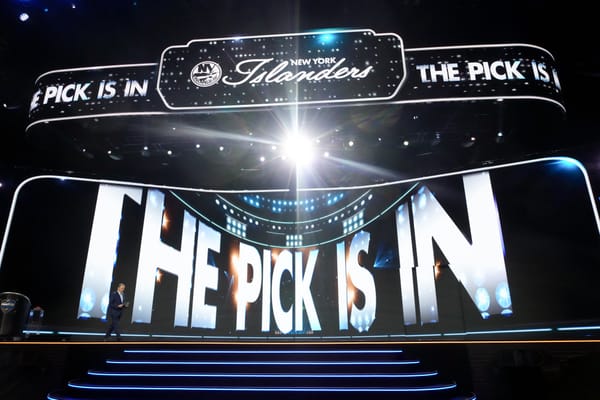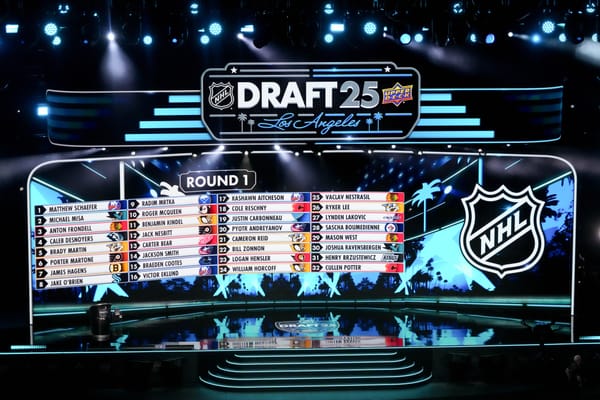Rangers By The Numbers Analytics Game #28 Preview: Rangers @ Oilers
A statistical look at the second meeting between the New York Rangers and Edmonton Oilers. Score adjust that Corsi, Edmonton fans. This team isn't quite above water in the shot attempt battle, and score effect is a real thing. Hush now, MSM naysayers who believe Edmonton is evidence that analyti
| Time | Sunday, 9:30 EST | TV | MSG/SN-P |
| Season Series | 0-1 | Last Meeting | L - Nov 9 - Oilers 3-1 |
| The Enemy | The Copper & Blue | Scoring Leaders | R. Nash 18-12-30 |
Rangers | CATEGORY | Oilers |
| 13-10-4 | SEASON RECORD | 7-18-5 |
| 30 (4th Metro) | Points | 19 (7th Pacific) |
| 1.11 (19th NHL) | Standing Points Per Game | 0.63 (30th NHL) |
| Won 2 | Streak | Lost 3 |
| 3.00 (5th) | Goals For Per 60 (GF60) | 2.17 (28th) |
| 2.70 (17th) | Goals Against Per 60 (GA60) | 3.37 (29th) |
| 15.1 (24th) | Power Play % | 13.2 (26th) |
| 81.2 (16th) | Penalty Kill % | 79.1 (20th) |
| 9.6 (11th) | PIM / GP | 9.1 (6th) |
| 30.2 (15th) | Shots For / GP | 28.8 (24th) |
| 29.5 (16th) | Shots Against / GP | 29.2 (14th) |
| 49.2 (21st) | 5v5 Shots For % | 49.6 (18th) |
49.5 (19th) | SCORE ADJUSTED CORSI | 48.9 (20th) |
| 49.0 (22nd) | Raw 5v5 Corsi | 51.0 (14th) |
| 49.3 (22nd) | Within 1 5v5 Corsi | 50.4 (15th) |
| 49.0 (20th) | Score Adjusted Fenwick | 48.4 (21st) |
| 105.3 (5th) | 5v5 Corsi Pace / 60 (ranked low to high) | 106.2 (6th) |
| 2.84 (1st) | 5v5 Goals For / 60 | 1.90 (23rd) |
| 2.38 (20th) | 5v5 Goals Against / 60 | 2.89 (29th) |
| 48.0 (24th) | 5v5 OZS % | 51.2 (13th) |
| 9.98 (1st) | 5v5 Shooting % | 6.64 (27th) |
| 91.90 (19th) | 5v5 Save % | 90.06 (29th) |
| D. Boyle +5.0 M. Hunwick +4.3 | 5v5 Corsi Rel % Leaders (min 150 min) | T. Hall +5.0 J. Eberle +4.9 |
| D. Girardi -6.9 T. Glass -5.6 | 5v5 Corsi Rel % Anchors (min 150 min) | M. Hendricks -5.6% J. Joensuu -5.2% |
| R. Nash 3.94 D. Brassard 2.61 | 5v5 Points / 60 Leaders (min 150 min) | B. Pouliot 2.11 R. Nugent-Hopkins 2.06 |
The Oilers are a fun bunch.
They lose a lot because they can't score, have trouble defending prime ice (low and high slot) and sport very poor starting goaltending. They are prone to "the big mistake," making for entertaining GIF fodder, because they are young, their vets aren't very skilled, and they don't seem to have a structured approach to their preferred rush transitioning style of hockey.
Some might point to their raw 5v5 corsi, the measure of all shot attempts for/against as an indicator that they aren't quite as bad as their bottom-dwelling goals for/against. That their PDO is an indicator of "bad luck." I'm sorry, those people would be sorely mistaken. They'd be wrong. They'd be told by myself and both math nerds and get-off-my-lawners alike to pound sand. They stink. #HereComeTheOilers.
Here's the thing about PDO. It is 5v5 sh% and sv% slapped together. League average is around 8% sh%, and 92% sv%. So if your team is around 100 PDO (or 1000 depending on how it is being displayed), the assumption is that your team is probably not feeling the effect of a good or bad luck streak.
Right? No, not quite. This is not how it should be expressed, though I know many analysts are just given to a "well you know what I mean" type of attitude about it. I'm sorry, but it is, in some respects, lazy analysis. Really, year-to-date PDO should be compared against the historical cumulative player averages for on-ice sh% and sv% to determine whether the number is outlandishly high or low as compared to a larger sample. If it is, then there may be some luck involved, or just small sample size craziness, or maybe something in the systems and usage/TOI decisions that is sending things out of whack.
Heck, maybe the goalie is between changing something about his preferred style and he hasn't quite committed it to muscle-memory. Maybe half the team got a new stick deal with Bauer and don't like their mid-kick flex. I know I don't. Those sticks suck.
The point is...take PDO with several grains of salt, and try to drill down deeper on what it means for the particular team.
Oilers' Sh% and SV% are their own doing.
It is all about the fact that they don't generate a lot of sustained offensive pressure and though they get around the net, they don't score at a high rate there because they usually only get one chance. Watch them play tonight, you'll see. It is a fun-and-gun style where individually skilled young players fly down the ice and usually take low percentage shots because its the NHL and NHL defensemen aren't so prone to being punished by ISO crossovers and dunks.
Even poor gap controllers like Dan Girardi can usually take away prime ice and force a guy to fire off-balance and leaning away from a good shooting angle/lane if he starts the transition in position. This leads to low sh% because of a propensity for taking marginally effective shots that don't generate a lot of rebounds they can get to. Never mind that they don't have the personnel to make hay with any rebounds laying out there:
The Oilers don't exactly have the personnel for balanced lines that can back teams off on occasion with a well-executed chip and chase or laying up on a zone entry to wait for support, nor the apparent focus on systems (or maybe just the fallibility of youth in the systems) that can penalize teams for focusing on the controlling entry-forward. They simply settle for bad shots, don't generate shots off of rebounds, and hope they can get a few chances from their high skill players in the low slot where they actually can do damage.
The end result is unsustained attacks when the game is at evens and they aren't way behind. This plays out in their score-adjusted Corsi of 48.9% (20th), which reveals that they truly aren't in the upper-half of the NHL in the shot attempt battle, but for score-effect of teams turtling a bit after they get a lead. The attempts they get after that are often repelled by the defensive shell teams go into anyway.
Edmonton's CF% Trailing = 54% (all shot attempts. They are trailing often)
Edmonton's FF% Trailing = 51.8% (Corsi-blocks. Revealing that a decent number of those chances are blocked)
On the other side of the ice, their goaltending simply isn't good enough. They have two netminders in Ben Scrivens and Viktor Fasth who have very little track record of success. Scrivens got hot for the Kings last year when Jonathan Quick was injured. He rode that short sample to a solid contract for himself, but had done little else. Fasth got hot for the Anaheim Ducks for about 20 games during the lockout-shortened 2012-13 season. Last year, he was injured, then castoff in favor of the Jonas Hiller / Fred Andersen duo. He never has performed even close to the standard he set for himself. I'm not sure what the Oilers expected when they brought these two to war this season.
They each get slaughtered by tough chances in the high probability areas of the ice (Sv%H). The "Big Mistake" stuff. And, while Edmonton actually does ok at limiting the volume of high probability shots, they give up a lot of pressure early in games, and the goalies yield the goals from those areas. They aren't particularly worse than a league average goalie in this area. But they play from behind early in games and never really get a footing until after they've been trailing. It's a bizarre thing.
More importantly though, shots from everywhere else are going in at a higher rate than league average, whether it be by tip-ins or simply bad goaltending. So it doesn't matter all that much that they are actually "improved" defensively this season in the high probability areas. It doesn't compensate for elsewhere.
The Rangers are Easier To Explain
The Rangers, on the other hand, are kind of easy to explain on their face. At least at this point of the season, though we all believe better times lie ahead.
They have this guy. His name is Rick Nash. He has been going berserk this season and scoring at an insanely high rate. The Rangers also have a few other guys, like Kevin Klein, who are doing this as well. Those guys have been doing it at 5v5. It is a bit out of character, or beyond anything they've done previously. It is also a bit having to do with the fact that when the Rangers are scoring, they are often doing so on transition rush opportunities leading to laterally transitioning passes for one-timers and high probability slot chances. Those are the types of chances that score more often than any other. Outside of that, the Rangers aren't exactly cranking up a lot of sustained offensive zone pressure, so their total shot attempts aren't all that indicative of an "elite possession team." If anything, they are actually, pretty low event, as indicated by their current Corsi Pace per 60 minutes.
So they are getting by on those high percentage chances going in, but may see a regression in sh% if those chances dry up or if players like Nash stop scoring at rates much much higher than usual. When that happens, their above normal PDO (101.9, 3rd NHL) will probably come down a bit. As will their league-leading 2.84 5v5 GF60, unless they improve on the possession battle, produce more shot attempts, and make up for this normal regression.
Then again, Henrik Lundqvist is performing at about league-average even-strength (91.9%). And we all know that he is typically above-average. So maybe it is sustainable. And hopefully it will lead to a better stretch of winning hockey.
Pay special attention to the Hextally shot charts (again courtesy of the indispensable war-on-ice.com) below. Note where the opportunities are coming from and at what rates, as well as how each goaltender is doing in saving them. Let this map of probability region success (again courtesy of war-on-ice) be your guide to the game as to where the prime ice for scoring is.
This game is pretty simple. Prevent the Oilers' skilled players from blitzing gaps to get prime 'danger zone' rush scoring chances where their high-skilled, if not young and inexperienced, forwards can shine. Take those high probability lanes that they don't get to often enough (as evidenced below) away, and profit. On the other end of the ice, make them pay for giving up premium real estate with a goalie who simply cannot be expected to perform well against numerous solid scoring chances.




